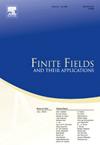几种新的置换多项式及其复合逆
IF 1.2
3区 数学
Q1 MATHEMATICS
引用次数: 0
摘要
我们重点研究了L(X)+Trm3m(X)s / Fq3的置换多项式,其中Fq是具有q=pm元素的有限域,p是素数,m是正整数,Trm3m(⋅)是Fp3m到Fpm的相对迹函数,L(X)是Fq3上的线性化多项式,s>;1是正整数。更准确地说,我们提出了上述形式的Fq3上六类新的置换多项式:一类是偶特征有限域上的置换多项式,三类是奇特征有限域上的置换多项式,其余两类是任意特征有限域上的置换多项式。进一步,我们证明了这类置换多项式与已知的相同形式的置换多项式是不等价的。我们还提供了这类置换多项式的组合逆的显式表达式。本文章由计算机程序翻译,如有差异,请以英文原文为准。
Some new classes of permutation polynomials and their compositional inverses
We focus on permutation polynomials of the form over , where is the finite field with elements, p is a prime number, m is a positive integer, is the relative trace function from to , is a linearized polynomial over , and is a positive integer. More precisely, we present six new classes of permutation polynomials over of the aforementioned form: one class over finite fields of even characteristic, three classes over finite fields of odd characteristic, and the remaining two over finite fields of arbitrary characteristic. Furthermore, we show that these classes of permutation polynomials are inequivalent to the known ones of the same form. We also provide explicit expressions for the compositional inverses of each of these classes of permutation polynomials.
求助全文
通过发布文献求助,成功后即可免费获取论文全文。
去求助
来源期刊
CiteScore
2.00
自引率
20.00%
发文量
133
审稿时长
6-12 weeks
期刊介绍:
Finite Fields and Their Applications is a peer-reviewed technical journal publishing papers in finite field theory as well as in applications of finite fields. As a result of applications in a wide variety of areas, finite fields are increasingly important in several areas of mathematics, including linear and abstract algebra, number theory and algebraic geometry, as well as in computer science, statistics, information theory, and engineering.
For cohesion, and because so many applications rely on various theoretical properties of finite fields, it is essential that there be a core of high-quality papers on theoretical aspects. In addition, since much of the vitality of the area comes from computational problems, the journal publishes papers on computational aspects of finite fields as well as on algorithms and complexity of finite field-related methods.
The journal also publishes papers in various applications including, but not limited to, algebraic coding theory, cryptology, combinatorial design theory, pseudorandom number generation, and linear recurring sequences. There are other areas of application to be included, but the important point is that finite fields play a nontrivial role in the theory, application, or algorithm.

 求助内容:
求助内容: 应助结果提醒方式:
应助结果提醒方式:


